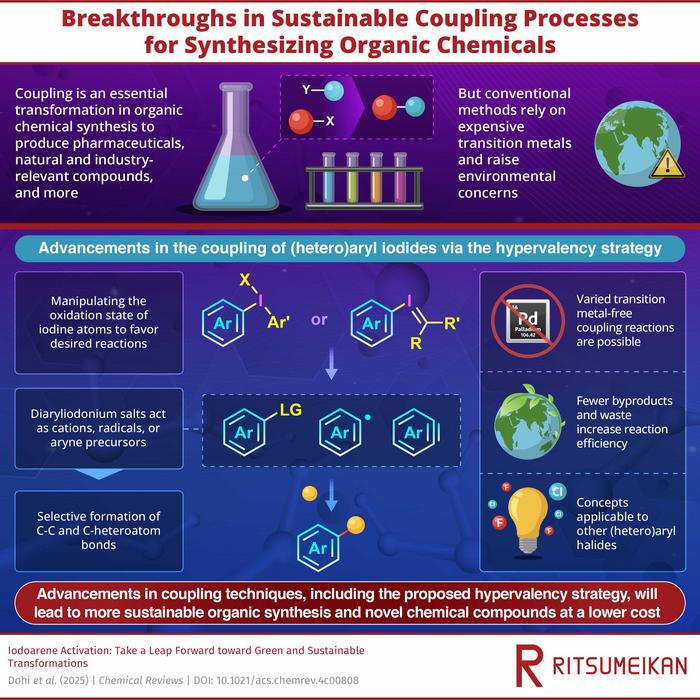In the realm of organic chemistry, coupling reactions stand as a crucial innovation, enabling the synthesis of essential chemical bonds utilized in a variety of sectors, including pharmaceuticals, agrochemicals, and advanced materials. These reactions are foundational to the field of modern organic synthesis; however, for many years, they have depended heavily on transition metal catalysts, such as palladium. These precious metals, while effective, pose several significant challenges. They are not only costly but also scarce and environmentally detrimental due to their tendency to generate unwanted byproducts in the synthesis process.
The growing awareness of environmental issues has mobilized researchers to explore alternatives to these traditional coupling methods. This drive stems from a desire to develop strategies aligned with the principles of green and sustainable chemistry (GSC). Scientists are intent on minimizing waste and lowering the reliance on precious transition metals like palladium, all while ensuring high efficiency and selectivity in reactions. This transition is vital for creating more sustainable methods for industrial and pharmaceutical synthesis, which are increasingly being called for by both consumers and regulatory agencies.
Recently, an impressive review article authored by a team of researchers, including Professor Toshifumi Dohi from Ritsumeikan University’s College of Pharmaceutical Sciences and Professor Yasuyuki Kita from the Research Organization of Science and Technology, has provided significant insights into the advancements in transition metal-free coupling methods. The publication, titled “Iodoarene Activation: Take a Leap Forward toward Green and Sustainable Transformations,” was made available online on March 7, 2025, and later published in Volume 125, Issue 6 of Chemical Reviews on March 26, 2025. This comprehensive review outlines the emergence of innovative strategies to activate aryl-iodide bonds under environmentally friendly conditions.
At the heart of this research is the hypervalent iodine strategy, which has garnered attention for its potential to revolutionize coupling processes. The authors, along with other collaborators from Ritsumeikan University, delve into the unique properties of diaryliodonium salts as intermediates in coupling reactions. This innovative approach allows researchers to manipulate the oxidation state of iodine effectively, leading to the creation of aryl cation-like species, radicals, and aryne precursors. Such advancements significantly reduce the necessity for costly catalysts and improve the atom economy in coupling reactions.
The hypervalent iodine-mediated coupling has surfaced as a promising alternative that boasts a broad substrate scope, thereby enabling the efficient synthesis of diverse molecular architectures. This method exhibits a high tolerance for various functional groups, making it particularly appealing for medicinal chemistry applications. Additionally, researchers have devised methods to recycle the aryl iodide byproducts generated during these reactions, which addresses the previous concerns regarding waste associated with traditional coupling methods. The reduction of waste not only enhances the efficiency but also aligns with the goals of sustainable development.
Moreover, the review does not limit itself to the hypervalent iodine strategy. It discusses a range of alternative transition metal-free activation methods that include base-promoted aryl–iodide dissociation, photoinduced activation, electrochemical activation, and electrophotochemical activation. Each of these alternative methods offers distinct advantages, including lower energy consumption, the ability to operate under mild reaction conditions, and the elimination of hazardous reagents. Through this review, the authors aim to guide and inspire further research endeavors in the field, emphasizing that a comprehensive understanding of these methods can catalyze innovative solutions to the present challenges in organic chemistry.
The increasing necessity for greener and more efficient chemical synthesis methods underscores the importance of these emerging strategies. As the demand for sustainable practices in chemistry grows, the methodologies articulated in this review could reshape future practices in organic chemistry. They not only promise to reduce environmental impacts but also hold the potential to lower production costs for vital pharmaceuticals and fine chemicals. As the field of organic synthesis continues to evolve, the insights provided in this review can lay the groundwork for subsequent breakthroughs, fostering a new generation of sustainable chemistry practices.
The collective efforts of Dohi, Kita, and their colleagues represent a significant step toward the realization of coupling methods that align with the principles of sustainability. Their work highlights that the scientific community is not merely a passive observer of environmental concerns but is actively engaged in seeking innovative solutions that harmonize industrial needs with ecological responsibilities. The transition toward greener chemistry is not solely an academic exercise; it is a pressing necessity driven by consumer demand and regulatory pressures for cleaner practices. This review serves as a beacon for researchers aiming to navigate the evolving landscape of organic synthesis, presenting a roadmap toward more sustainable practices.
For decades, the coupling reaction has demonstrated its transformative power in organic synthesis. Still, the reliance on environmentally taxing metal catalysts has created a burgeoning need for innovative alternatives. As highlighted in this review, the advancements in transition metal-free methodologies, particularly the hypervalent iodine approach, represent not only a technical achievement but also a moral imperative for the scientific community. By developing these methods with sustainability in mind, researchers are paving the way for a future where chemical synthesis can occur with minimal environmental impact, ultimately benefiting society at large.
The rigorous and thoughtful contributions of Professor Dohi, Professor Kita, and their team at Ritsumeikan University exemplify the best of scientific inquiry, where the quest for knowledge aligns with the responsibility to protect our planet. As the research landscape shifts toward sustainability, the lessons drawn from this review should inspire a collective response from the wider scientific community, encouraging collaborative efforts that could yield even greater advancements. As these new methodologies take root, the future of organic chemistry may well reflect a balance between scientific innovation and ecological stewardship, a promise that every chemist should aspire to fulfill.
References:
- Title of original paper: Iodoarene Activation: Take a Leap Forward toward Green and Sustainable Transformations
- Journal: Chemical Reviews
- DOI: 10.1021/acs.chemrev.4c00808
Image Credits: Dr. Toshifumi Dohi and Dr. Yasuyuki Kita from Ritsumeikan University, Japan
Keywords: coupling reactions, sustainable chemistry, green chemistry, transition metal-free methods, hypervalent iodine, organic synthesis, pharmaceuticals, medicinal chemistry, environmental sustainability, eco-friendly synthesis, organic chemistry, research innovation




